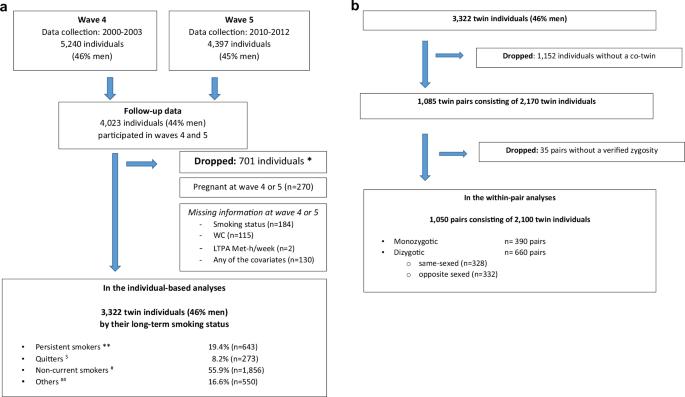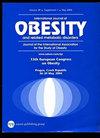Associations of smoking status and leisure-time physical activity with waist circumference change—10-year follow-up among twin adults
IF 3.8
2区 医学
Q1 ENDOCRINOLOGY & METABOLISM
引用次数: 0
Abstract
This cohort study investigated the associations of smoking status and leisure-time physical activity (LTPA) with weight circumference (WC) change. In the FinnTwin16 cohort, 3322 twins (46% men) reported smoking status, LTPA, and WC in early adulthood and 10 years later providing information on essential covariates at baseline. The effects of smoking status and LTPA (metabolic equivalent tasks [MET]-h/week) on WC change (cm) were estimated by modeling WC value at the end of follow-up and adjusted for baseline WC in linear regression models. Within-pair associations were analyzed using linear fixed-effect regressions among 660 dizygotic and 390 monozygotic twin pairs. During the 10-year follow-up, 36.4% (n = 273) of baseline daily smokers quit smoking. Among those who quit daily smoking, the mean WC increase was 8.4 cm (SD 8.1). Quitters who smoked daily at baseline increased WC by about 2 cm more than continuing smokers (adjusted β 2.04; 95% CI 0.94, 3.14). This association was not robust after shared familial influences were controlled for. In general, the participants decreased LTPA during follow-up, except the quitters with the mean LTPA increase of 5.0 MET-h/week (SD 35.0). Independently of smoking status, each additional MET-h/week was associated with 0.06 cm less WC increase (adjusted β −0.06; 95% CI −0.07, −0.05). This association was replicated in the within-pair analyses. Smoking cessation seems to be associated with WC increase, but familial confounding may be involved in this process. LTPA appears to mitigate increase in WC independently of smoking status and familial influences.

吸烟状况和闲暇时间体育活动与腰围变化的关系——对双胞胎成人的10年随访。
背景:本队列研究探讨吸烟状况、休闲时间体力活动(LTPA)与体重周长(WC)变化的关系。方法:在FinnTwin16队列中,3322对双胞胎(46%男性)报告了成年早期和10年后的吸烟状况、LTPA和WC,提供了基线时基本协变量的信息。吸烟状况和代谢当量任务(代谢当量任务[MET]-h/周)对WC变化(cm)的影响通过随访结束时的WC值建模来估计,并在线性回归模型中调整基线WC。对660对异卵双胞胎和390对同卵双胞胎进行线性固定效应回归分析。结果:在10年随访期间,36.4% (n = 273)的基线每日吸烟者戒烟。戒烟者的平均腰围增加8.4厘米(标准差8.1)。在基线时每天吸烟的戒烟者比继续吸烟者多增加约2厘米的腰围(调整β 2.04;95% ci 0.94, 3.14)。在控制了共同的家庭影响后,这种联系并不牢固。总体而言,除戒烟者LTPA平均增加5.0 MET-h/周(SD为35.0)外,随访期间参与者的LTPA均有所下降。与吸烟状况无关,每增加MET-h/周,WC增加减少0.06 cm(调整后β -0.06;95% ci -0.07, -0.05)。这种关联在配对内分析中得到了重复。结论:戒烟似乎与WC增加有关,但家族混杂因素可能参与了这一过程。LTPA似乎减轻了WC的增加,与吸烟状况和家庭影响无关。
本文章由计算机程序翻译,如有差异,请以英文原文为准。
求助全文
约1分钟内获得全文
求助全文
来源期刊

International Journal of Obesity
医学-内分泌学与代谢
CiteScore
10.00
自引率
2.00%
发文量
221
审稿时长
3 months
期刊介绍:
The International Journal of Obesity is a multi-disciplinary forum for research describing basic, clinical and applied studies in biochemistry, physiology, genetics and nutrition, molecular, metabolic, psychological and epidemiological aspects of obesity and related disorders.
We publish a range of content types including original research articles, technical reports, reviews, correspondence and brief communications that elaborate on significant advances in the field and cover topical issues.
 求助内容:
求助内容: 应助结果提醒方式:
应助结果提醒方式:


